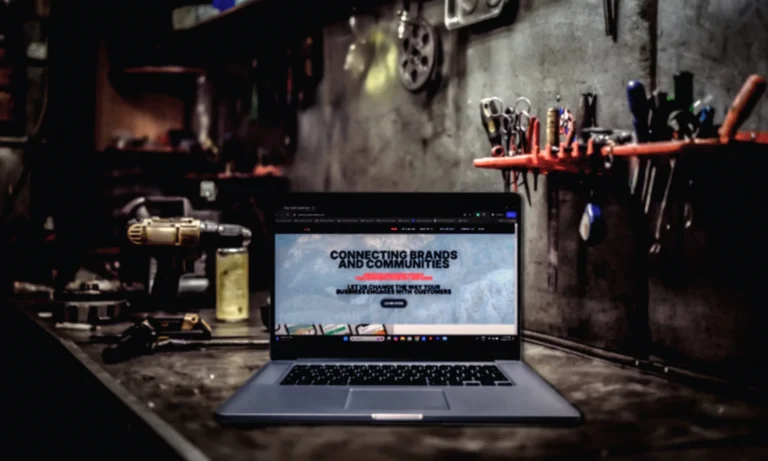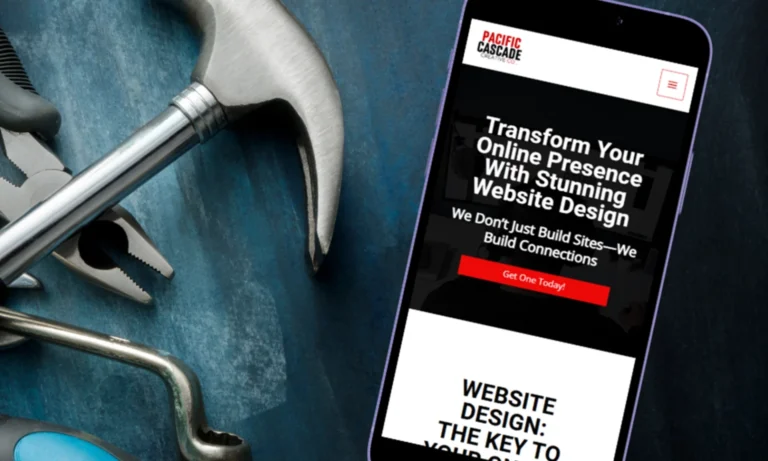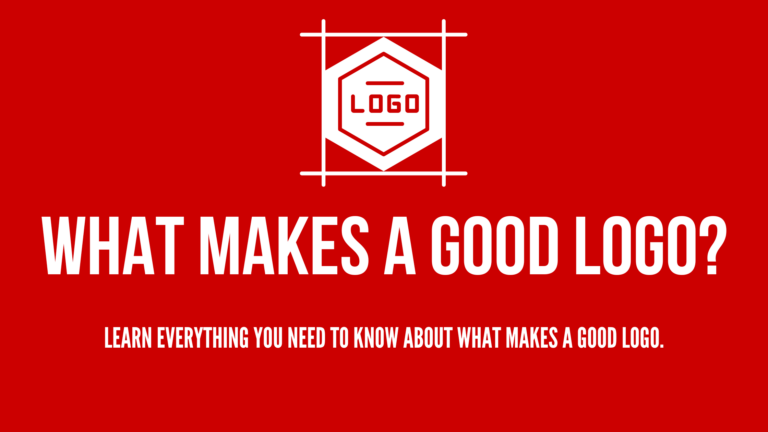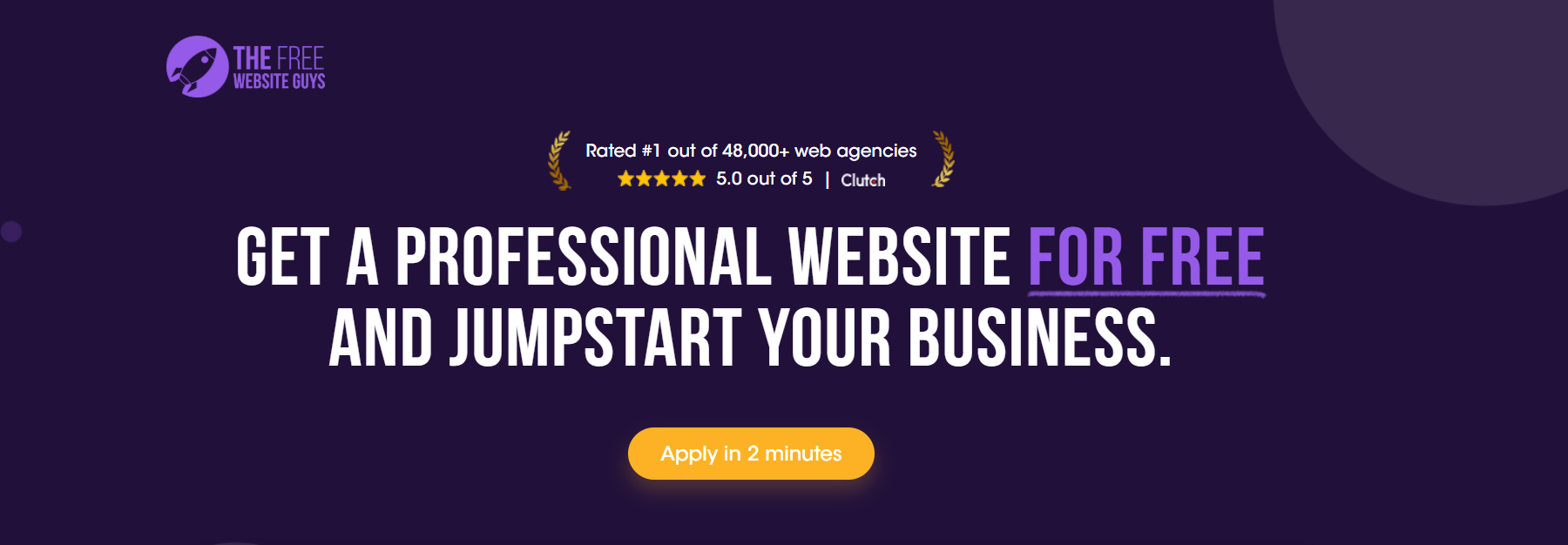
Exposing “The Free Website Guys” Free Website Scam: What You Need to Know
Introduction To The Free Website Guys Scam
All small business owner wants to save money, especially when it comes to things that seem menial such as web design. So when a company advertises a “free” website, it sounds like a great deal, until reality hits. The fact of the matter is undeniable: These offers aren’t actually free; they’re carefully designed to lock you into expensive, long-term contracts, force you onto low-quality hosting, or limit your control over your own website. In the worst cases, businesses find themselves trapped with a website they don’t own, unexpected fees, and no easy way out.
Would you work for free? Probably not. So why would someone do a complex job like website design for an absolute stranger for free? They wouldn’t.
In this blog, we’ll explore the pitfalls of their “free” offer, including:
- The bait-and-switch tactics of their free website model.
- The hosting trap that locks you into unnecessary expenses.
- The poor design quality that undermines your brand.
- The extended wait times that delay your business progress.
- How correcting these mistakes later costs far more than building a proper site from the start.
Let’s delve into the truth behind The Free Website Guys and why their service is not the golden ticket it claims to be.

Website Design Scams And Your Business
As a business owner, you are responsible for making smart decisions. Around 20-25% of businesses fail within their first year, with the failure rate climbing to approximately 50% within five years and 65% within ten years. These are directly tied to lack of knowledge, poor decision-making, and financial mismanagement. For businesses to succeed in the modern era, It is critical to familiarize yourself with fraudulent schemes, data-stealing tactics, and the importance of cyber security.
Falling victim to website design scams can have profound and multifaceted impacts on businesses, affecting both their financial health and operational integrity. One of the most immediate consequences is significant financial loss. Scammers often demand substantial upfront payments for services they either poorly execute or fail to deliver entirely. For instance, some small business owners have reported losses ranging from $2,500 to as much as $50,000 after engaging with fraudulent web developers who disappeared after payment.
These financial setbacks can be particularly devastating for small to medium-sized enterprises operating on tight budgets.
Beyond direct monetary losses, such scams can severely damage a company’s reputation. A poorly designed or malfunctioning website reflects negatively on the business, leading potential customers to question its credibility and professionalism. This erosion of trust can result in decreased customer engagement and lost sales opportunities. Moreover, if a business’s website is compromised due to substandard security measures implemented by fraudulent designers, sensitive customer data may be exposed, further tarnishing the company’s image and potentially leading to legal complications.
Operational disruptions are another critical concern. Businesses may find themselves unable to update content, manage products, or process transactions if they lack control over their websites. This loss of functionality can halt business operations, leading to missed opportunities and revenue loss. Additionally, the time and resources required to rectify issues caused by fraudulent designers—such as hiring new developers, rebuilding the website, or addressing security breaches—can divert attention from core business activities, further impacting productivity and growth.
The most basic and common website design scams come in the form of mandatory hosting and maintenance fees, restrictive service agreements, or hidden costs for even the most basic website updates. This type of scam is the best-case scenario. Odds are you will just get ripped off for a couple hundred bucks, get a crappy website and can just trash it and move on due to security concerns.
In some of the worst-case scenarios companies even hold your domain name hostage, preventing you from moving your site elsewhere without paying hefty penalties. Instead of getting a high-quality business website, you end up with a generic template that can’t be customized to fit your needs—unless you pay extra.
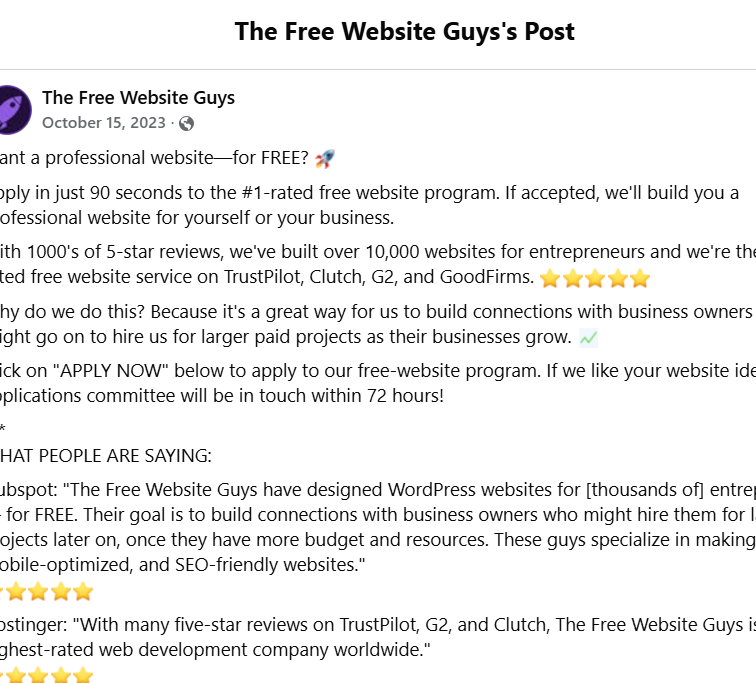
The Free Website Guys Scam
Enter The Free Website Guys, a service claiming to offer high-quality websites at no cost. But as the saying goes, “If something sounds too good to be true, it probably is.” How about “There is no such thing as a Free Lunch”? Behind the enticing offer lies a series of tactics that will leave you frustrated and paying more in the long run.
Many aspiring website owners stumble upon The Free Website Guys, attracted by their seemingly incredible offer of a free website. On the surface, it appears to be a generous service aimed at helping startups and small businesses. However, beneath the polished marketing lies a business model riddled with hidden costs, subpar results, and significant downsides.
At first glance, The Free Website Guys seem like a dream come true for those seeking a website without upfront costs. They promise to build your website for free, claiming their team of professionals will handle everything for you. However, this “free” scam comes with significant strings attached.
Hidden Costs and Upsells
While the initial pitch sounds appealing, you quickly discover that the “free” service is tied to mandatory purchases like hosting or premium themes, often at inflated prices. These upsells are how the company makes money, exploiting the customer’s lack of knowledge about alternative options. Often, these services require you to use their proprietary hosting platforms, locking you into ongoing fees and restricting your ability to transfer your site elsewhere.
Essential features like SSL certificates, contact forms, or mobile responsiveness are frequently excluded from the free package, prompting additional charges to implement these necessary components. Moreover, the initial design is typically a generic template with minimal customization, and any desired enhancements come at a premium.
Additionally, control over your domain name may be retained by the provider, complicating future efforts to move or manage your website independently. These hidden costs and constraints can result in a website that is far from free, potentially costing more than if you had invested in a reputable web design service from the outset. It’s crucial to thoroughly research and understand the terms of any free website offer to avoid falling victim to these common pitfalls.
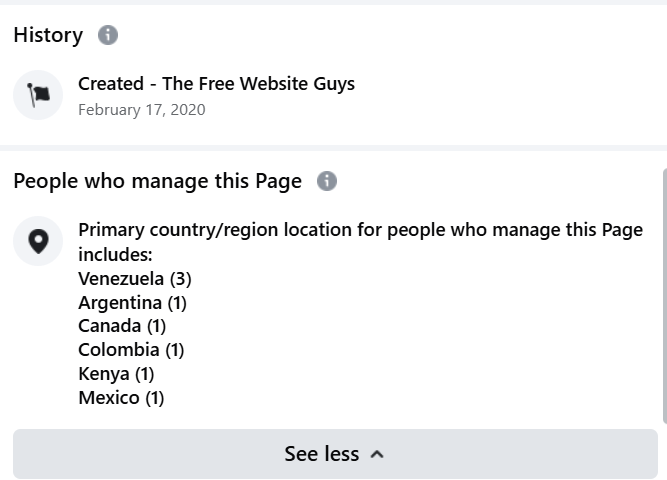
Poor Transparency
a significant issue is the lack of transparency exhibited by some providers. A common deceptive practice involves misrepresenting their location. For instance, a company may claim to be based in the United States or Europe to gain clients’ trust, while actually operating from a different country. This misrepresentation can lead to challenges in communication, time zone differences, and difficulties in enforcing legal agreements. Additionally, some providers may exaggerate or falsify their qualifications, presenting themselves as experienced professionals when they lack the necessary skills or credentials. This deceit can result in subpar website quality, security vulnerabilities, and a failure to meet client expectations.
Another prevalent tactic is the use of fabricated reviews and testimonials to create a false sense of credibility. Scammers often populate their websites and social media profiles with glowing endorsements from non-existent clients, complete with stock photos or fictitious names. These fake testimonials are designed to mislead potential clients into believing the service is reputable and trustworthy. Engaging with such deceptive providers can lead to financial loss, compromised personal information, and significant setbacks for businesses relying on their online presence. It’s crucial for individuals and businesses to conduct thorough due diligence, such as verifying the authenticity of reviews, checking the provider’s stated location, and assessing their qualifications before committing to any web design services.
The Hosting Scam
One of the most glaring issues with Free Website Scams like The Free Website Guys is their hosting trap. To qualify for a free website, you are required to purchase hosting through their recommended providers. While this might seem like a fair trade-off at first, it’s often a predatory practice.
Companies that offer “free” website design often use deceptive tactics to lock you into their low-quality hosting services. One of the most common methods is requiring you to purchase hosting through their preferred provider before they begin work on your site. They claim this is necessary to keep the service free, but in reality, they earn commissions from the hosting provider or even own the hosting service themselves. These hosting plans are typically overpriced, slow, and lack essential security features, but since they control the setup, you have little choice but to comply.
Another tactic is retaining ownership of your domain name. They register it on your behalf but under their own account, making it difficult or expensive to transfer elsewhere. If you decide to leave their hosting, you may be forced to buy back your domain at an inflated price or lose your website altogether. Additionally, they often disable standard migration options, meaning you can’t easily move your site to a better hosting provider without completely rebuilding it. These restrictions keep you dependent on their system, allowing them to charge ongoing fees for poor service while making it difficult to leave.
Overpriced Hosting Plans
The hosting plans you are forced to buy are frequently overpriced compared to reputable alternatives like Bluehost, SiteGround, or Hostinger. What’s worse, these plans often include long-term contracts, locking you into years of unnecessary expenses.
The hosting services tied to “free” website design offers are often both overpriced and underperforming, creating an ongoing burden for business owners. While reputable hosting providers offer affordable plans with competitive features, these so-called “free” website providers typically charge inflated rates for subpar service. For example, a basic shared hosting plan from a trusted provider might cost $5–$10 per month, but these companies often require clients to pay $20–$50 per month for hosting with significantly fewer resources. The price discrepancy is due to hidden commissions, reseller markups, or the company owning the hosting infrastructure themselves and maximizing their profit.
Beyond the high cost, these hosting services frequently suffer from poor performance. They may place too many websites on a single server, leading to slow loading times, downtime, and unreliable security. Many lack basic necessities like SSL certificates, daily backups, or proper server optimization, forcing clients to pay even more for features that should be standard. As a result, businesses end up stuck with an expensive, sluggish website that provides a poor user experience, harms Google rankings, and ultimately drives away potential customers.
Limited Control
Once you’ve purchased hosting through their affiliates, you might find that you have limited control over your website. In many cases, the hosting account is set up in their name, not yours, making it difficult to migrate or manage the website independently.
These tactics severely limit your control over your own website, making it difficult to manage, update, or move your site as your business grows. One of the biggest issues is domain ownership—many of these companies register the domain under their own name instead of yours. This means you don’t actually own your website’s address, and if you ever want to switch providers, you may have to buy back your domain at an inflated price or risk losing it entirely. Even if they allow a transfer, they may impose unnecessary delays or charge hidden fees to make the process as difficult as possible.
Another major control issue is restricted access to your website’s backend. These companies often limit or block access to critical settings, such as your hosting dashboard, database, or file system. You may only have a basic user login, preventing you from installing plugins, customizing design elements, or making performance improvements. Some even disable the ability to back up or export your site, forcing you to stay locked into their hosting and services. If you ever decide to leave, you might have no choice but to start from scratch, losing all your content and progress. These restrictions put them in full control, making you dependent on their overpriced and underperforming services
Poor Website Design
Another major downside of Free Webiste Design from services like The Free Website Guys is the quality of the websites they deliver. Customers frequently complain about lacklustre design, minimal functionality, and outdated aesthetics. Websites built through “free” website scams are often poorly designed, lacking the quality and functionality needed for a professional online presence. These companies typically use generic, low-quality templates that offer little customization, making sites look outdated, unprofessional, and identical to many others. Because these templates are built for mass production rather than individual business needs, they often have cluttered layouts, inconsistent branding, and poor mobile responsiveness, leading to a frustrating user experience. Additionally, many of these sites use bloated or outdated code, which can cause slow load times and compatibility issues across different devices and browsers.
Beyond poor design, these websites typically suffer from terrible SEO and weak Google rankings. Many of them lack basic on-page SEO elements, such as optimized title tags, meta descriptions, header structures, and alt text for images. Because they’re built with cheap, cookie-cutter templates, they often have poor site architecture, making it difficult for search engines to properly index pages. Additionally, slow hosting and a lack of proper security features (such as SSL certificates) can harm rankings even further, as Google prioritizes fast, secure, and well-structured websites. Since these companies don’t invest in SEO or long-term website performance, businesses that rely on these free sites struggle to attract organic traffic, leaving them virtually invisible in search results.
Cookie-Cutter Templates
One of the biggest flaws of “free” website scams is their reliance on generic, mass-produced templates that are reused across countless businesses. Instead of designing a unique website tailored to your brand, these companies use the same cookie-cutter layout with only minor changes, such as swapping out a logo or changing a color scheme. This leads to a lack of originality, making your website blend in with countless others that look nearly identical. For businesses trying to establish a strong online presence, this is a major problem—when potential customers see a bland, templated site, they may assume the business is unprofessional or not credible.
Beyond aesthetics, using the same template across multiple sites hurts SEO and search rankings. Search engines like Google prioritize unique, high-quality content and penalize duplicate or boilerplate designs that offer little value. When multiple businesses have nearly identical page structures, coding, and content, Google struggles to differentiate them, often ranking them lower. Additionally, these mass-produced templates usually lack proper technical SEO optimization, slowing down page indexing and further harming visibility. Without a unique, well-structured website, businesses relying on these “free” designs are at a severe disadvantage, struggling to stand out in both user experience and search engine results.
No Customization
A website from a “free” design service is anything but custom or tailored to your business. These companies rely on pre-made, generic templates that are slightly modified for each client, rather than building a site from the ground up to meet specific needs. Instead of crafting a layout, functionality, and branding elements that align with your goals, they simply swap out a logo, update a few colors, and insert placeholder text. This one-size-fits-all approach fails to represent your brand identity, making your website feel impersonal and disconnected from your business.
A true custom website considers factors like target audience, industry requirements, SEO strategy, and user experience, all of which are ignored in these free template-based designs. You won’t get tailored features, strategic calls to action, or unique content that helps your business stand out. Instead, you’re left with a generic, cookie-cutter site that looks like countless others, lacking the depth, functionality, and performance of a properly built website. Ultimately, these “free” sites are designed for speed and profit—not for delivering an effective online presence that actually helps your business grow.
Long Wait Times
These “free” website services often come with long wait times before the final product is delivered, leaving businesses stuck without an online presence for weeks or even months. Because these companies rely on a high-volume, low-effort business model, they often take on more clients than they can handle. With minimal staff and little incentive to prioritize quality, projects are delayed while businesses are left waiting for a website they need to attract customers. This lack of urgency can be especially damaging for startups, seasonal businesses, or those needing a website for an upcoming promotion, as every day without a functioning site means lost revenue and missed opportunities.
Even after the long wait, the final product is usually underwhelming, unless the client has no experience with professional web design. Many business owners assume that because they now have a live website, it’s good enough—but in reality, what they receive is a generic, poorly optimized, and barely functional site that does little to help them grow. The lack of customization, poor design choices, and weak SEO mean the site struggles to rank in search engines, fails to engage visitors, and ultimately doesn’t generate leads or sales. This results in businesses either having to spend more money fixing the site or starting over entirely, proving that the “free” offer was never really worth it.
Delays in Communication
One of the biggest frustrations with these “free” website services is the poor communication that comes with dealing with an unresponsive or offshore-based team. Many of these companies misrepresent their location, claiming to be based in North America or Europe when, in reality, they operate from overseas with limited staff. This leads to time zone conflicts, where clients wait hours or even days for responses to simple questions, delaying progress and making revisions painfully slow. Critical updates or urgent fixes often take far longer than expected because the team isn’t available when you need them.
Beyond slow responses, miscommunication and language barriers create even bigger issues. Many of these companies outsource work to designers with little understanding of industry-specific needs, branding, or marketing best practices. As a result, instructions are misunderstood, and revisions rarely turn out as expected. Clients are often forced to go back and forth repeatedly to clarify details, wasting valuable time. In many cases, businesses settle for a mediocre final product just to be done with the frustrating process, rather than getting the high-quality website they actually need. These delays and communication breakdowns make the experience exhausting, proving that a “free” website often costs more in frustration and lost time than it’s worth.
Missed Deadlines
Constantly missed deadlines are a common frustration with “free” website services, and they stem from the company’s high-volume, low-effort approach. These businesses take on far more clients than they can realistically handle, prioritizing quantity over quality. Since they have little incentive to meet promised timelines—after all, they’ve already locked you into their hosting or upsells—they continue to push back delivery dates without consequence. Clients are left waiting weeks or even months past the original deadline, often with vague excuses about technical issues, workload, or needing additional information that was never requested upfront.
These delays can seriously harm a business, especially for startups, seasonal industries, or those launching a new service. Without a functioning website, companies lose credibility, miss out on potential customers, and struggle to market themselves effectively. Even when the site is finally delivered, it’s often rushed and unfinished, with broken links, missing content, or incomplete pages. Businesses that were relying on a quick and professional online presence end up trapped in a cycle of endless delays, poor communication, and a disappointing final product, proving that a “free” website is anything but a good deal.

More Expensive to Correct in the Long Run
What seems like a cost-saving choice at first often ends up being far more expensive in the long run. Here’s why:
Correcting Design Flaws
Fixing a poorly designed website is often more challenging and expensive than starting from scratch. Many professionals charge a premium for rebuilding sites with flawed foundations.
Migration Issues
Because the hosting account is tied to their system, migrating to another provider often involves additional fees or technical challenges.
Lost Opportunities
The delays, poor design, and hidden costs can hinder your online presence, leading to lost revenue and missed opportunities for growth.
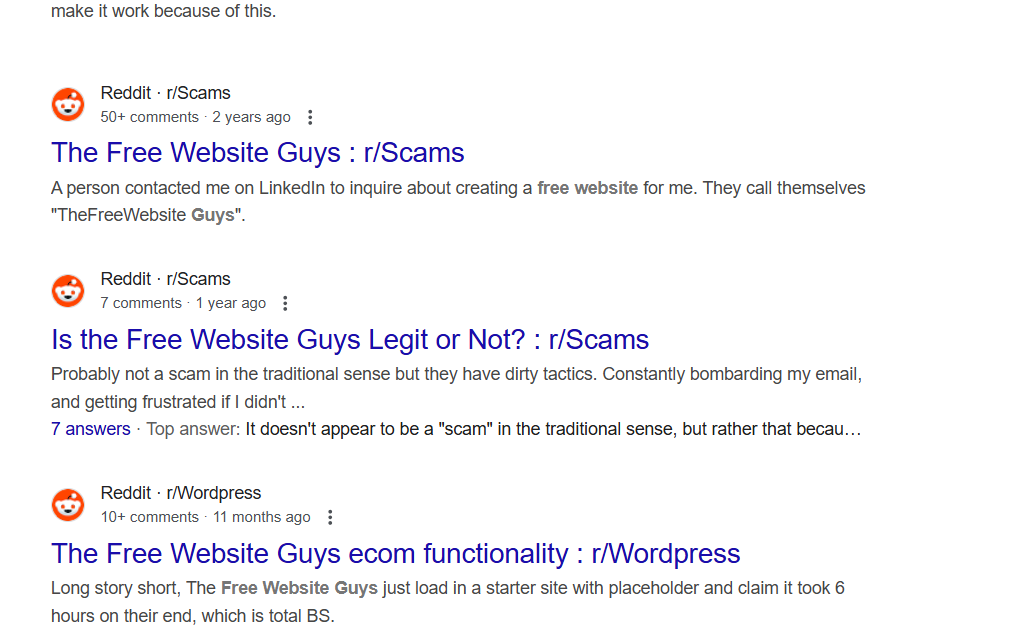
Conclusion
While the idea of a “free website” is tempting, the reality of working with The Free Website Guys is far less appealing. From hidden hosting costs to poor design and excessive delays, their service often creates more problems than it solves. For businesses looking to establish a credible online presence, investing in a professional web designer or using reputable DIY platforms like WordPress or Wix is a far better choice.
Remember, your website is often the first impression customers have of your brand. Don’t let the allure of a “free” service undermine your business goals. Instead, choose a solution that offers transparency, quality, and long-term value.


